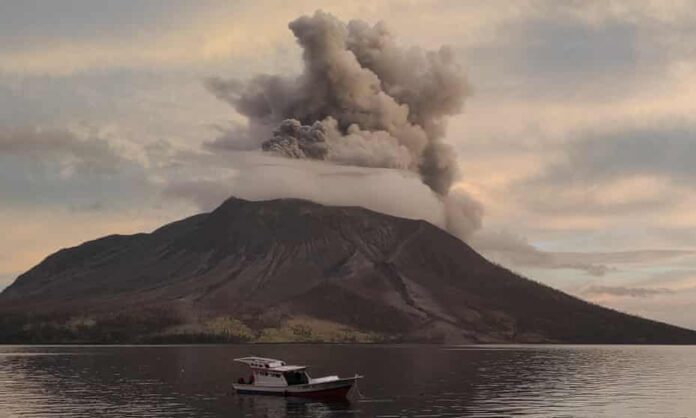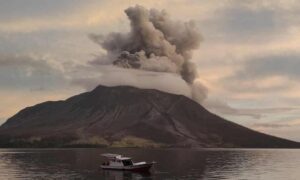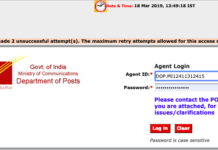An Indonesian Volcanic Eruption has once again dominated headlines, this time with Mount Ruang unleashing its fury. The eruption, occurring on Sulawesi island, has prompted mass evacuations and raised fears of a potential tsunami. With more than 11,000 people forced to flee their homes, the impact of this natural disaster is palpable.
Table of Contents
Mount Ruang’s Wrath Unleashed
Mount Ruang, located in Indonesia’s North Sulawesi province, has erupted multiple times since Friday afternoon. The eruption columns, reaching heights of 1,200 meters, have blanketed nearby areas with ash and debris. The eruption’s intensity has led to the temporary closure of the Manado city airport, disrupting travel and further complicating relief efforts.
Evacuation Efforts and Tsunami Fears
Authorities have scrambled to evacuate residents from the volcano’s vicinity, fearing not only the immediate dangers of ash and hot volcanic clouds but also the potential for a tsunami. The memory of past disasters, such as the 1871 tsunami triggered by a volcanic collapse, looms large. The evacuation efforts, though challenging, are crucial for safeguarding lives in the face of uncertainty.
Impact on Communities
The eruption has left a trail of destruction in its wake, with homes, roads, and infrastructure covered in volcanic ash. Thousands of residents have been displaced, their lives upturned by the sudden onset of disaster. The economic toll is yet to be fully realized, as agricultural lands lie dormant under layers of ash, threatening livelihoods for the foreseeable future.
Triumph Trident 660 Specifications: Unveiling the Ultimate Riding Experience
Environmental and Economic Repercussions
The environmental impact of the Indonesian Volcanic Eruption extends beyond immediate ash fallout. The spread of volcanic debris raises concerns about long-term ecological damage, particularly to marine ecosystems. Additionally, the disruption to air travel and tourism exacerbates economic woes, further straining Indonesia’s recovery efforts.
Preventive Measures and Response Strategies
In the face of such calamities, disaster preparedness and response strategies become paramount. Coordination between local authorities, government agencies, and international organizations is essential for effective evacuation and relief operations. Furthermore, investing in early warning systems and infrastructure resilience can mitigate the impact of future eruptions.
World’s Cancer Capital India- A Comprehensive Analysis
Indonesia’s Volcanic Vulnerability
Indonesia’s geographic location along the “Ring of Fire” makes it particularly susceptible to volcanic activity. With 120 active volcanoes dotting its landscape, the country grapples with the constant threat of eruptions and their aftermath. The need for continuous monitoring and risk assessment remains a top priority for safeguarding communities.
Global Solidarity in Crisis
Amidst the chaos, stories of resilience and solidarity emerge, as communities come together to support one another. International aid and support pour in, underscoring the importance of global cooperation in times of crisis. The Indonesian Volcanic Eruption serves as a reminder that, in the face of adversity, humanity’s greatest strength lies in unity and compassion.
Long-term Recovery and Rebuilding
As the immediate crisis subsides, attention turns to long-term recovery and rebuilding efforts. Reconstruction of infrastructure, rehabilitation of affected ecosystems, and support for displaced communities are essential components of the recovery process. Sustainable development practices can help mitigate the risk of future disasters and promote resilience in vulnerable areas.
Lessons Learned and Future Preparedness
The Indonesian Volcanic Eruption offers valuable lessons for disaster management and preparedness. Improved monitoring systems, community education initiatives, and cross-border collaboration are vital for reducing the impact of future eruptions. Governments and organizations must invest in resilience-building measures to protect lives and livelihoods in volcanic-prone regions.
PSEB 10th Result 2024: Unveiling the Triumphs and Trials of Punjab’s Students
Conclusion
As Indonesia grapples with the aftermath of yet another volcanic eruption, the road to recovery may be long and arduous. However, amidst the devastation, there is hope. Through collective action and resilience, communities can rebuild and emerge stronger. The Indonesian Volcanic Eruption, while a tragedy, offers valuable lessons in preparedness, cooperation, and the indomitable human spirit.
FAQ’s
1. What caused the Indonesian Volcanic Eruption?
– The Indonesian Volcanic Eruption, particularly the eruption of Mount Ruang, was triggered by the movement of tectonic plates beneath the Earth’s surface, leading to the release of pent-up magma and volcanic gases.
2. How many people have been affected by the eruption?
– More than 11,000 people living in the vicinity of Mount Ruang have been forced to evacuate their homes due to the eruption’s dangers, including ashfall, falling rocks, and potential tsunamis.
3. Is there a risk of a tsunami following the eruption?
– Yes, there is a concern that a volcanic collapse into the sea could trigger a tsunami, similar to historical events like the 1871 tsunami. Authorities are closely monitoring the situation and have issued evacuation orders as a precautionary measure.
4. What measures are being taken to ensure public safety?
– Local authorities, in coordination with government agencies and international organizations, are conducting mass evacuations to move residents out of harm’s way. Additionally, monitoring systems are in place to detect any signs of escalating volcanic activity.
5. How long will the eruption last, and what are the future risks?
– The duration of the eruption is uncertain, as volcanic activity can vary unpredictably. Even after the eruption subsides, there may be ongoing risks such as lahars (mudflows), ashfall, and potential secondary eruptions that could pose threats to surrounding communities.
6. What is being done to assist affected residents?
– Relief efforts are underway to provide essential supplies, shelter, and medical assistance to displaced residents. International aid and support are also being mobilized to complement local relief initiatives and alleviate the humanitarian crisis.
7. How will the eruption impact the environment and local ecosystems?
– The eruption’s ashfall and volcanic debris can have detrimental effects on soil fertility, water quality, and biodiversity in affected areas. Rehabilitation efforts will be needed to restore ecosystems and mitigate long-term environmental damage.
8. What can individuals do to support relief efforts?
– Individuals can contribute to relief efforts by donating to reputable humanitarian organizations providing aid to affected communities. Additionally, raising awareness about the situation and advocating for sustainable disaster preparedness measures can help mitigate the impact of future volcanic eruptions.














